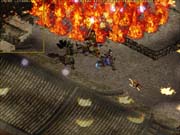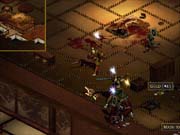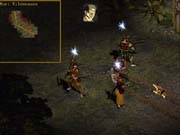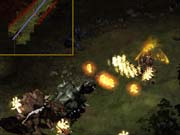Japan is a country with a rich history and its own fascinating mythology, and Throne of Darkness uses these as a basis for a hack-and-slash action RPG set in a fictional medieval era in the country's past. Featuring countless battles and plenty of exotic treasures to be found, Throne of Darkness is the first effort by San Francisco-based Click Entertainment, a company cofounded by two developers who previously worked on Blizzard's extremely successful mid-'90s action RPG, Diablo. The influence of the original Diablo on Throne of Darkness is clearly evident in the game's isometric perspective and emphasis on combat--but while Throne of Darkness may be similar, you'll find that the Japanese setting isn't its only distinguishing feature. Though it has few real role-playing elements to speak of and though some aspects of its gameplay aren't well implemented, Throne of Darkness does succeed in offering plenty of good-looking combat sequences, which are repetitive but interesting nevertheless.

In Throne of Darkness, you'll take command of the loyal samurai retainers of one of four Japanese clans, each of which has a similar goal: to rid the land of the Dark Warlord Zanshin, an incredibly powerful demon warrior that resides in his own fearsome fortress. The recently awakened Zanshin has already corrupted the countryside--it's all become shrouded in darkness and filled with nefarious beasts, ogres, bandits, and undead. Only the four clans' samurai warriors, as well as their respective daimyo masters, remain unaffected. To save the land, you'll have to guide your samurai all across the country, fighting evil, gaining new skills, and finding new and better equipment. You'll take on some side quests in your search for Zanshin. These are good diversions, but they're as straightforward as the rest of the game and usually just involve going out of your way to kill one fiend or another.
The clan you choose has little effect on the game--you'll have the same seven classes of samurai at your disposal, regardless. These include the leader, a venerable and charismatic warrior; the aptly titled brick, a giant of a man; the archer, master of kyudo, the unique Japanese bow-and-arrow style; the swordsman, who's exceptional with a sword in each hand; the berserker, a brutal fighter who prefers polearms; the ninja, a versatile assassin; and the wizard, practitioner of the occult. These characters are distinguishable by their individual appearances, by the weapons they can use, by the spells they can learn, and by their starting statistics for attributes such as strength, dexterity, and vitality. In reality, they can all become quite capable in battle, and many of them share analogous roles, making them not so different in practice as you might hope or expect. Still, Throne of Darkness' most interesting feature is that it readily lets you command any combination of up to four of these characters at any given moment, and thanks to your daimyo's magical powers, you can easily and almost instantly swap different samurai in and out of your active group.

Having to direct four characters in real time may sound like a tall order, but in truth, you directly control just one while the computer handles the others. This makes Throne of Darkness play somewhat similarly to another Diablo-inspired game, Darkstone, a hack-and-slash action RPG from 1999 that lets you play with two characters at once. Of course, Throne of Darkness lets you manage even more. At any time, you can quickly switch your control from one samurai to the next, and injured samurai can be teleported out of action and replaced with one of their fully rested comrades--this unique mechanic is central to the combat in Throne of Darkness and gives the game a distinct feel. Combat itself is simplistic but frantic since it plays out so quickly--you just left-click your mouse on targets repeatedly to swing or shoot at foes, and alternately, you can use the right mouse button to cast a variety of magic spells. Also, you can easily switch between two sets of weapons at the touch of a hotkey--for instance, from a razor-sharp katana to deadly accurate shuriken--but you'll usually have just one weapon per character that you'll prefer to use.
The game's interface can be a bit confusing at first, but it actually works quite well for the most part, once you get the hang of it. What's called the "daimyo interface" is easily accessible with a keyboard hotkey, and it's here that you can swap samurai in and out of your group just by clicking on their portraits. Samurai not in your group slowly regenerate their health and "ki" points, which are used for casting spells. Teleporting samurai back and forth uses up some of your daimyo's ki, which constantly recharges. The daimyo can also resurrect slain samurai, though this is particularly taxing for him--if many of your samurai are killed in a difficult battle, you'll have to wait a while before you're back in force. Each samurai has his own unique character stats sheet, item inventory, and spell list. Separate interface screens are also available for dealing with the blacksmith, who can repair your items, make new ones, and customize old ones by combining them with magical components for a fee; and the priest, who can identify artifacts, purify cursed items, and offer your magical goods to the gods in exchange for more spell knowledge. The blacksmith and the priest become available early in the game, and you can magically trade with them at any point, much like the way you can switch samurai. You can also call up an unobtrusive minimap that will float in the upper left-hand corner of the screen, though unfortunately, you can't scroll this map to help get your bearings, and your own view is always locked on your samurai. At least you can resize the map to your preference.
Throne of Darkness has a battle tactics feature that looks promising, but it ultimately doesn't work well and can just as easily be ignored. The game lets you issue a variety of preset tactics that are named after animals, such as "frog" and "centipede." These tactics are selectable from a prominent green button on the interface panel, and triggering them causes your characters to change positions relative to one another and possibly switch weapons or switch between an aggressive and a defensive combat posture. However, while names such as "frog" and "centipede" may be in keeping with the game's far-eastern martial arts theme, they're not exactly intuitive. Indeed, in practice, none of the tactics make any kind of sense. They just throw your samurai into some arbitrary pattern. Not unless you right-click on each individual tactic and take note of where it's putting whom and what it's making whom do will any of these prove remotely useful. Even if you eventually find a few that you like in theory, their value is still pretty limited--your samurai will lock themselves into the same relative position every time, and unless you manually rotate the formation and reset it, they'll stay where they are. This makes it difficult to maintain formations that protect weaker party members like the wizard, since you'll need to readjust the formation every time you change direction.

There's an option to create your own tactical formations. You can reposition the samurai, set their posture to aggressive, neutral, or defensive, and specify whether you want them to use a melee weapon, a ranged weapon, or a spell. This feature seems promising too, but it's actually very limiting, or at least it seems that way since the computer is rather single-minded in how it controls your samurai. Computer-controlled samurai using ranged weapons or spells will just stand there and fire--they won't try to keep their distance or dodge enemy attacks. Also, magic-using samurai will repeatedly cast the one spell that you've selected for them. This particular shortcoming ends up making most of the game's dozens of spells all but useless in practice--a frustrating fact, since all the samurai have the ability to use magic and should have been better-equipped to take advantage of it.
Some of the game's spells are clearly meant to be complementary--for instance, some temporarily increase your attack speed, while others lower the resistances of your enemies. But it's just not practical to quickly switch between different spells in battle, partly because only four universal spell hotkeys are available and mostly because computer-controlled samurai will use only one spell at a time, in place of their standard attack. In the end, about the only viable means of using spells in battle is to take direct control of the wizard character. It's unfortunate that the magic system and the computer artificial intelligence in Throne of Darkness are lacking; otherwise, the game could have had some real strategic depth to it if the tactics editor were more robust and gave you some meaningful "if...then" choices for customizing your characters' behavior in different situations. As it is, the tactics feature is more or less extraneous, and the same goes for many of the game's spells, which aren't well balanced besides being hard to use--you'll find that some are much stronger than others, so you'll fire these off occasionally and just leave the rest be.

The fact that the computer doesn't effectively control your characters means having seven of them to deal with becomes a double-edged sword--all the samurai make the game interesting, but managing them can be a chore. That is, you'll end up spending about as much time looking at your characters' inventories and stats as you're spending in battle. Characters gain experience levels individually, and you'll get to assign points to their core attributes and learn or improve in various magic spells whenever this happens--and having seven characters gaining experience from battle means it'll happen very often. You're also constantly finding new stuff during the game--and deciding who gets to have what can be a laborious process, even though it's usually fun. What complicates matters is that, especially early on, your equipment can easily break, so you'll need to have the blacksmith individually repair each damaged item. Repairs cost a small amount of gold, but unfortunately, for some reason, the samurai don't share their wealth, so you'll often have to pass money from one character to the other just to complete a simple repair. Constantly having to fix helmets and gloves and move money around sounds about as fun as it is. Another ill-conceived design decision is the inclusion of a charisma statistic for each character, which simply determines how much of a discount that character gets from the blacksmith and the priest. The leader starts with a huge charisma bonus--you'll end up making him the middleman for all your exchanges, but the designers might as well have just taken the middleman out of the process.

One of the more interesting features in Throne of Darkness is that the blacksmith can customize your equipment by giving it the magical properties of various artifacts you find. However, you'll likely have less opportunity to make custom items than you'd like, since customizing equipment can get extremely expensive--especially because the only way to earn gold is by killing creatures. Surprisingly, you can't actually sell your extra stuff--you can only donate it to the blacksmith for its raw materials or sacrifice it to the gods through the priest. The relative shortage of funds in Throne of Darkness seems strange, as do the often-lengthy waiting periods necessary for the blacksmith to complete his work, though these things will make you appreciate the few items you'll afford to customize all the more.
The game's fairly uninformative manual states, "One of the best ways to experience Throne of Darkness is to play with other people," which isn't necessarily the case--one of the best aspects of Throne of Darkness is that it lets you command seven samurai all by yourself. In multiplayer, you can still control all seven characters against opposing players, though you can also share control of the party with allied players. Throne of Darkness offers multiplayer gameplay both over a local area network and online over Sierra's proprietary player-matching service, an effective if bare-bones system that functions much like Blizzard's Battle.net. Multiplayer isn't exactly the focus of Throne of Darkness as it is with Blizzard's Diablo II. The multiplayer mode eliminates the game's peripheral quests and automatically opens up most of the waypoints found throughout the gameworld, and it challenges competing players to be the first to defeat the Dark Warlord. Once done, the action begins anew--only this time, the player who defeated the Dark Warlord gets to control Zanshin's personal vanguard, consisting of zombielike equivalents of the seven samurai. This king-of-the-hill-style of play seems novel, but it takes a long time to get to Zanshin, much less to defeat him, so multiplayer Throne of Darkness is not conducive to quick matches. At least you can just as easily hop straight to a rival's castle and run amok on his own turf. Of note, you can't import your single-player characters to Sierra's servers, though you can use them in a LAN game. Also, the game doesn't offer the higher difficulty options that helped give the Diablo series so much replay value--make no mistake, Throne of Darkness is plenty challenging and takes a while to complete, but once you've finished the game, there isn't too much incentive to go through it again.

The prerendered 2D characters found throughout Throne of Darkness look good for the most part. They're smoothly animated and move about fluidly, and the stylized artwork both for your samurai and for the various foes they'll face gives the game a memorable appearance. It's a bit unfortunate that there isn't more variety in the characters--as in the original Diablo, you'll fight various shades of the same types of monsters over and over, and your own samurai will change in appearance only when they equip different weapon types or completely different armor types. More-minor changes in a samurai's equipment--a helmet or a mask, for example--aren't reflected on the character graphic. The game is locked in 800x600 resolution. The scenery isn't especially well detailed, and much of it tends to be recycled from one area to the next, but since the action itself is pretty repetitive, this isn't really an issue. The audio is quite good, from its convincing Japanese-accented English voice-over to its effective percussion-heavy ambient musical score. The sounds of combat are all mostly well done, though some of the monsters sound pretty generic and all the sound effects are repetitive. Nevertheless, Throne of Darkness is aesthetically pleasing overall, which is good since you'll spend the entire game looking at the same set of characters, running through the same types of environments. Of further note, the game's nearly nonexistent loading times mean that the gameplay never gets interrupted.
Throne of Darkness is a good game overall, despite some underdeveloped features and a few unnecessary design elements. The simple mechanics, the constant action, the continuous discovery of newer, more powerful equipment, and the generally well done graphics and sound all add up to a game that's certainly addictive, just as it was meant to be. Throne of Darkness isn't an overly ambitious game and doesn't deviate too much from the formula that Diablo popularized--but it's a perfect example of why that formula can be enjoyable.